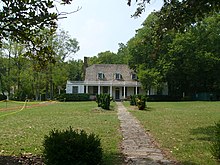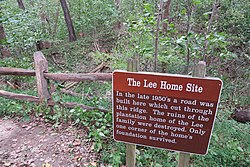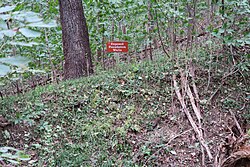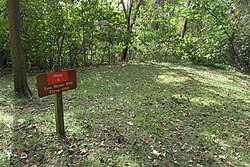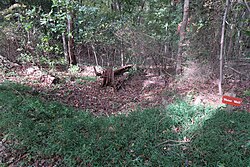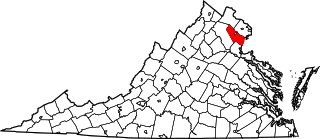
Woodbridge is a census-designated place (CDP) in Prince William County, Virginia, United States, located 20 miles (32 km) south of Washington, D.C. Bounded by the Occoquan and Potomac rivers, Woodbridge had 44,668 residents at the 2020 census.

Charles Lee was an American lawyer and politician from Virginia who served as United States Attorney General from 1795 until 1801, and as United States Secretary of State ad interim from May 13, 1800, to June 5, 1800., after serving as prosecutor for the City of Alexandria and serving in the Virginia House of Delegates from Fairfax County.

Henry Lee III was an early American Patriot and U.S. politician who served as the ninth Governor of Virginia and as the Virginia Representative to the United States Congress. Lee's service during the American Revolution as a cavalry officer in the Continental Army earned him the nickname by which he is best known, "Light-Horse Harry". He was the father of Robert E. Lee, who led the Army of Northern Virginia against the Union Army during the American Civil War.
William Lee was a Virginia merchant and member of the Lee Family of Virginia who served as an American diplomat during the Revolutionary War, became a plantation owner through marriage, and represented Elizabeth City, Warwick and York Counties in the Virginia Senate. His son William Ludwell Lee became an early Lee family genealogist as well as left a will freeing his slaves.

William Fitzhugh was an American planter, legislator and patriot during the American Revolutionary War who served as a delegate to the Continental Congress for Virginia in 1779, as well as many terms in the House of Burgesses and both houses of the Virginia General Assembly following the Commonwealth's formation. His Stafford County home, Chatham Manor, is on the National Register for Historic Places and serves as the National Park Service Headquarters for the Fredericksburg and Spotsylvania National Military Park.

Stratford Hall is a historic house museum near Lerty in Westmoreland County, Virginia. It was the plantation house of four generations of the Lee family of Virginia. Stratford Hall is the boyhood home of two Founding Fathers of the United States and signers of the Declaration of Independence, Richard Henry Lee (1732–1794), and Francis Lightfoot Lee (1734–1797). Stratford Hall is also the birthplace of Robert E. Lee (1807–1870), who served as General-in-Chief of the Confederate States Army during the American Civil War (1861–1865). The Stratford Hall estate was designated a National Historic Landmark in 1960, under the care of the National Park Service in the U.S. Department of the Interior.

Richard Bland Lee was an American planter, jurist, and politician from Fairfax County, Virginia. He was the son of Henry Lee II (1730–1787) of "Leesylvania" and Lucy Grymes (1734–1792), as well as a younger brother of both Maj. Gen. Henry Lee (1756–1818) and of Charles Lee (1758–1815), Attorney General of the United States from 1795 to 1801, who served in both the Washington and Adams administrations.
Thomas Ludwell Lee, Sr. was a Virginia planter and politician who served in the House of Burgesses and later the Virginia Senate, and may be best known as one of the editors of the Virginia Declaration of Rights.

Capt. Henry Lee I (1691–1747) was a prominent Virginia colonist, planter, soldier and bureaucrat. Although today known mostly for his family connections below.

Leesylvania State Park is located in the southeastern part of Prince William County, Virginia. The land was donated in 1978 by philanthropist Daniel K. Ludwig, and the park was dedicated in 1985 and opened full-time in 1992.

Richard Lee I was the first member of the Lee family to live in America. Poor when he arrived in Virginia in 1639 on a ship with the colony's newly reappointed governor and the woman who became his future wife, by the time of his death, Lee may have been both the Virginia Colony's wealthiest inhabitant as well as its largest landholder. Lee had a varied career, for in addition to several important government and military posts, he became a merchant, planter and politician who served one term in the Virginia House of Burgesses as well as managed to negotiate several major political upheavals—both successfully and to his economic advantage.

Col. Henry Lee II (1730–1787) of Alexandria, Westmoreland, Virginia Colony, was an American planter, soldier, and politician, the father of Henry "Light-Horse Harry" Lee III, and grandfather of Robert E. Lee.

Sully Historic Site, is both a Virginia landmark and nationally registered historic place in Chantilly, Virginia.

Leesylvania, formerly known as Neabsco, is a census-designated place in Prince William County in the U.S. state of Virginia.

Philip Richard Fendall I (1734–1805) was an influential banker, lawyer, and merchant in Alexandria, Virginia. He was a member of the Lee family and a friend and business partner to George Washington. Fendall constructed the Lee-Fendall House on the corner of Washington and Oronoco Streets as a lasting home for his family.

Freestone Point Confederate Battery is a historic American Civil War gun emplacement located at Leesylvania State Park, Woodbridge, Prince William County, Virginia. The battery has four individual gun emplacements, which are fairly simple in configuration. All are formed by a large, deep, rectangular depression with high earthen berms built up on the north and south side of each depression. Three of the batteries are located on the cliff about 90 feet above the Potomac River. For five months, from October 1861 to March 1862, the batteries contributed to the Confederate military's success in blockading the Potomac River.

Laetitia Corbin Lee was an American colonist. She was the daughter of Henry Corbin, one of the most powerful and influential political leaders in the Colony of Virginia. In 1674 she married the politician Richard Lee II, and joined the prominent Lee family of Virginia. The Maryland branch of the Lee family descends from her through her son, Philip Lee of Blenheim Plantation. Another of her sons, Thomas, built Stratford Hall, the future family seat of the Lees.
Ludwell Lee was a prominent Virginia lawyer and planter who served in both houses of the Virginia General Assembly representing Prince William and Fairfax Counties and rose to become the Speaker of the Virginia Senate. Beginning in 1799, following the death of his first wife, Lee built Belmont Manor, a planation house in Loudoun County, Virginia, which today is on the National Register of Historic Places.



